Why the secret symbols of magic and witchcraft fascinate us
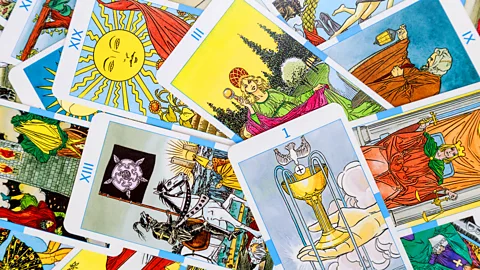 Getty Images
Getty ImagesFrom emoji spells to WitchTok, the mysterious, 600-year-old emblems of tarot and spell books are still resonating in the 21st Century. Clare Thorp explores the intriguing world of art, symbolism and magic.
Earlier this summer, a collection of Sylvia Plath's personal items went up for sale at Sotheby's. It included intimate love letters, recipe cards, a rolling pin, family photo albums and her and Ted Hughes's gold wedding bands. The rings sold for a respectable $38,000 (£28,000) – but this was mere pocket change compared to the most sought after item in the lot: Plath's personal tarot deck. Originally expected to fetch between $6,000 (£4,351) and $9,000 (£6,527), it eventually went for $206,886 (£150,037).
More like this:
The Tarot de Marseille deck was a 24th birthday gift from Hughes. Plath wrote in her journals of her wish to get better at reading tarot – but it played an important part in her art, too. She references the practice in her poem Daddy ("With my gypsy ancestress and my weird luck/ And my Taroc pack and my Taroc pack"), while The Hanging Man takes its name from a tarot card.
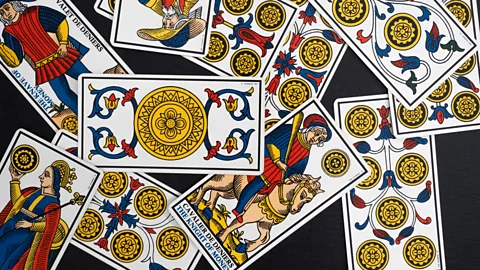 Alamy
AlamyTarot has been a muse for countless writers, artists and designers in their work – TS Eliot wrote of the "wicked pack of cards" in The Waste Land, Salvador Dalí created his own deck, while Andy Warhol made a film of the Velvet Underground having their cards read. Earlier this year, fashion house Dior cast models as the characters from a deck of tarot cards for its spring/ summer 2021 couture show (Christian Dior himself had his cards read before every show). Recently, the costume designer for the sci-fi film Dune revealed that tarot cards were a source of inspiration.
But tarot does not only inspire artists and designers – it's a powerful art form in its own right. Look at tarot decks across the last 600 years and you'll get a crash course in art history, from Renaissance Italy through to Art Nouveau and Art Deco, to Pop Art and digital collage. The symbols of tarot have been adapted and transformed hundreds of times over to reflect the time and culture in which they are created. "Tarot is really what you make of it, and that's why it's such an amazing medium for artists," author and editor Jessica Hundley tells BBC Culture. "It's a blank canvas with some parameters, in that these images that you're creating need to have some corresponding meaning."
Hundley is the editor of a series of books from Taschen, entitled The Library of Esoterica, that explore the visual history of the arcane. The weighty titles have focused on Astrology and, in the most recently published edition, Witchcraft – but Hundley says tarot was a natural beginning for the series. "Tarot felt like the right place to start because it is a totally visual, archetypal language," she says. "It's very much about our intuitive reaction to these archetypes."
![The book Tarot: The Library of Esoterica is one of a series published by Taschen (Credit: Taschen]](https://ichef.bbci.co.uk/images/ic/480xn/p0b1scw7.jpg.webp)
The book Tarot features more than 500 decks, spanning six centuries – and shows how different artists have put their own unique stamp on tarot. The Strength card, symbolising bravery in adversity, may typically feature a woman with a lion, but depending on the artist, that woman might be an Aztec warrior, Egyptian Queen or – in the 2015 Black Power Tarot – Tina Turner. She might be stroking the lion, riding on its back or holding its jaw open. It might not be a lion at all, but a grizzly bear, or an alligator. Yet all will convey a sense of inner strength overcoming obstacles. "It's really thrilling to see how people have interpreted and then completely changed it, but there's still that unifying archetype," says Hundley.
The oldest known existing tarot cards, the Visconti-Sforza deck, date back to 15th-Century Italy. Created for aristocrats, the cards are hand-painted, intricate pieces of art, featuring figures that would go on to become key tarot archetypes. Tarot originated as a parlour game, and it wasn't until the 18th Century that the cards became a tool for divination.
The most famous – and influential – tarot was created in 1909 when occultist Arthur Edward Waite commissioned artist Pamela Colman Smith to design a deck. If you've only seen one tarot deck, it's likely to be this, the Rider-Waite-Smith (often referred to as just the Rider-Waite) – still the most widely used in the world today. Both Colman and Waite were of the secret society the Hermetic Order of the Golden Dawn, devoted to the study of the occult (other included Bram Stoker and WB Yeats). Their deck reimagined and modernised tarot, reinterpreting the imagery to create a deck intended to reflect the reader using it. "The pictures are like doors which open unexpected chambers, or like a turn in the road with a wide prospect beyond," wrote Waite in the accompanying book, The Pictorial Key to Tarot.
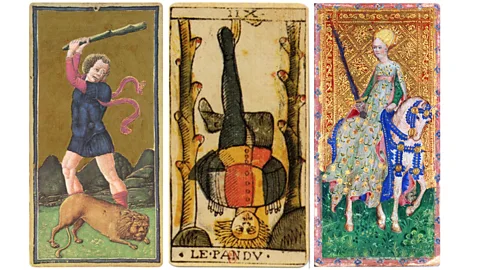 Alamy
AlamyPamela Colman Smith wrote in a letter that it was "a big job for very little cash" – but her vibrant illustrations were key in widening the appeal of tarot. "I think there's something about her intuitive understanding of these archetypes and her skill as an amazing graphic artist," says Hundley. "She went to the Pratt Institute, and was really well versed in commercial art and posters. So she understood how to convey them in a way that felt very inclusive, and allowed other people to understand them in a way I think they maybe didn't before. Tarot owes a huge debt to what she created."
And yet, the Rider-Waite deck, and tarot itself, may have faded into obscurity if Stuart R Kaplan, founder and chairman of US Games Systems Inc hadn't stumbled across it at a toy fair in 1968.
"He reprinted the Rider-Waite and distributed it globally," says Hundley. "If that hadn't happened and that deck hadn't somehow made it into his hands I don't know if tarot would have survived as anything more than sort of an obscure game." Today, tarot is thriving. While there are several specialist tarot publishers, self-publishing and crowdfunding has made it easier for any artist with a vision to create their own deck, leading to a diversification of the form and hundreds of different interpretations. Want a deck that reimagines tarot through the world of pasta? You're in luck.
Courtney Alexander, a multimedia artist based in Indiana, created her own deck, Dust II Onyx: A Melenated Tarot, when she couldn't find any cards that she felt connected with. "I thought to myself, okay, I'll create the deck that I want to have," she says. "The goal was to create not just a black deck in look, but I wanted it to embody blackness in essence and spirit." The 78 mixed-media collage paintings feature cultural myths, symbolism, history and icons within the black diaspora. She deliberately made her archetypes look otherworldly to "allow the readers to connect to something beyond their human existence and the limitations of it".
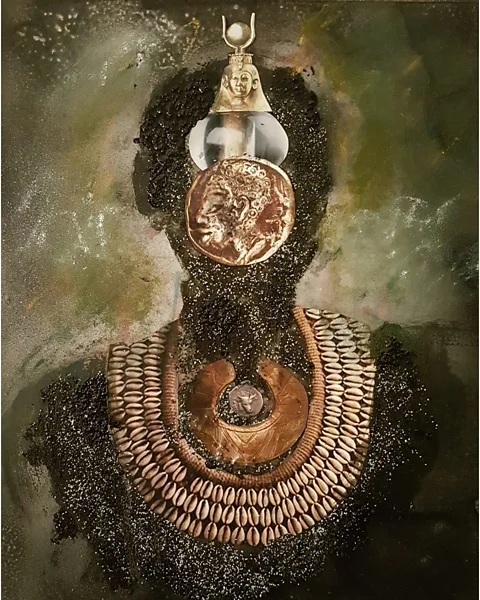 Dust II Onyx
Dust II OnyxThe deck was funded via Kickstarter, raising $30,000 (£21,754) in just one month. Alexander has sold more than 6,000 decks to date. "At one point in time tarot was just a very limited range of artwork and imagery that was very European in style. Now it's birthing a whole cultural language within itself that people can connect to. Everybody can find a version of it that they can work with."
For an artist, tarot provides both a distinct challenge and a unique way to connect. "You really get to stretch your artistic and creative muscle by creating such a large series of artwork," says Alexander. "I've had exhibitions where people get to see my work for a few seconds, but now people around the world have a constantly renewed relationship with my artwork. That's very special."
'Witchy vibes'
While the iconography of tarot is something anyone can take meaning from, other visual symbols of the occult are harder to decipher. In witchcraft especially, secret symbols have always played an important role. "The word occult means hidden, and the idea of your magic being very private and very personal is important for two reasons," says Pam Grossman, self-described witch, host of The Witch Wave podcast and co-editor of Taschen's Witchcraft. "Certainly because you don't want to be persecuted for practicing magic by your community, but secondly because there is this popular belief that the less you share your magic, the more potency it has."
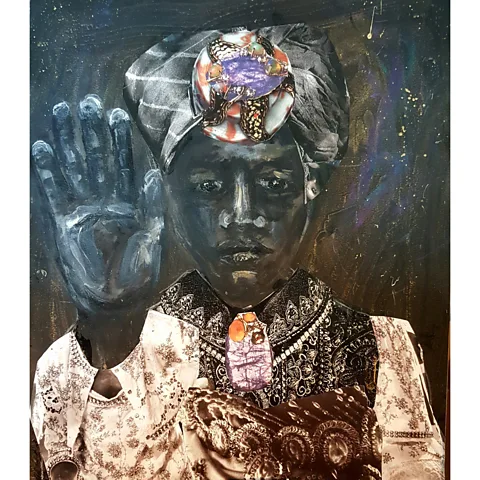 Dust II Onyx
Dust II OnyxSpell books – or "grimoires", an alteration of the mid-19th-Century French word grammaire – especially, were often illustrated with visual signs and symbols that were only meant for the creator. "Magic, even to this day is still a bit controversial, and so you have a long history of books that may have been created just for the individual to show to nobody," says Grossman.
While some symbols associated with witchcraft – such as the pentagram – are universal, others are more unique. Perhaps the most personal of these are sigils, which Grossman describes as a blend of artistry and witchcraft. "They are magical symbols that are charged with some kind of an intention to change or manifest something in one's life," she says.
While sigils have existed for centuries, it was the influential British occultist and artist Austin Osman Spare who pioneered a method of creating sigils that is commonly used today. This involves writing out an intention, condensing the letters and arranging the remaining letters into an image. "He came up with this method of taking text and deg the text into this beautiful glyph or symbol that he then would kind of infuse through various magical techniques to try to make things happen," says Grossman. "Ever since then we've seen a lot of other artists get inspiration from him and infuse their artworks with sigils."
Even before Spare, artists have long been fascinated with esoteric symbolism. Hilma af Klint, a pioneer of abstract art and devoted spiritualist, used many enigmatic shapes and symbols in her work. British-Mexican surrealist Leonora Carrington – who also created her own tarot deck – scratched or painted magical emblems or secret symbols into her artwork. Contemporary artist Elijah Burgher uses Spare's method to incorporate sigils into his work. "A lot of the sigils that he incorporates are about queerness, identity and sexuality," says Grossman. "[Sigils] have this gorgeous design element to them and people can get very specific about the colours that they're using and the shapes. There are some symbols that are universal but sigils are incredibly individual."
 Getty Images
Getty ImagesWith these aesthetic elements, it's perhaps no wonder that modern day witchcraft has found a home on social media. On TikTok, the hashtag #WitchTok has 20 billion views, and includes tarot readings, spells and lessons on how to create your own sigils. On Instagram #witchesofinstagram has nearly 8 million posts, and #witchyvibes close to 3 million.
Interest in tarot and witchcraft has been steadily increasing over the past few years. "I think whenever we are in times where we feel like we don't have control or we feel powerless, we gravitate towards tools and systems that can help us feel like we have agency," says Grossman. "We might not be able to control the pandemic or climate change, but we each do have power in our own selves and we do have the ability to make change in our lives, and to connect to something greater than ourselves."
For a social media generation that is all about self-branding, secret symbols and sigils have a natural appeal – even if not everyone who uses them understands their true meaning. "Look, witchcraft, let's be honest, it's popular not just because it's really meaningful and effective for people but it's aesthetically quite beautiful," says Grossman. "So certainly you have people who are using these symbols with a lot of knowledge and intention, and then you have other people who wear it on a t-shirt because they think it looks cool."
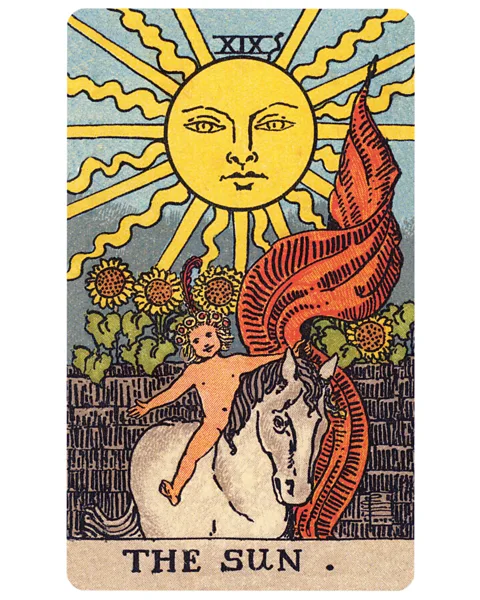 The Library of Esoterica/ Taschen
The Library of Esoterica/ TaschenUnderstanding cultural context and giving credit and appreciation is important, says Hundley. "But I think if you relate to an image and like it, sometimes you don't have to know why. There's a magic in just the appreciation of the aesthetic. There's a reason why we connect and maybe we don't always have to go deep and understand what it means."
As for emoji spells and online sigil generators, finding new ways to be creative is inevitable, according to Grossman. "The fact that people are using technology as part of their spell craft I think actually helps keep magick alive and relevant, and you know that's the beauty of it, that it adapts to its age."
Witchcraft: The Library of Esoterica is published by Taschen.
If you would like to comment on this story or anything else you have seen on BBC Culture, head over to our Facebook page or message us on Twitter.
And if you liked this story, sign up for the weekly bbc.com features newsletter, called The Essential List. A handpicked selection of stories from BBC Future, Culture, Worklife and Travel, delivered to your inbox every Friday.
